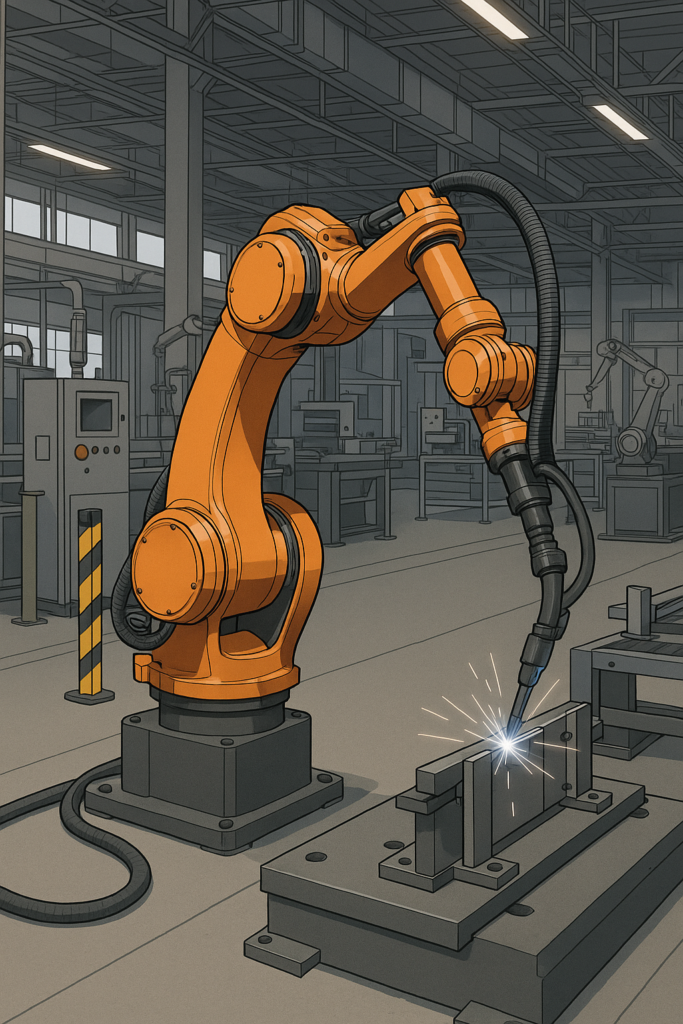Among the most flexible and significant systems in industrial automation and robotics is the 6-axis robot model. A mainstay in manufacturing, assembly, healthcare, and research, it provides versatility, range, and accuracy that few other robot designs can match. Knowing the 6-axis robot model is absolutely vital if you are investigating robotics for research, a job, or a hobby project. This book will cover what you need simply and plainly.

Understanding the 6-Axis Robot Model
A six-axis robot model is one with six degrees of freedom. A six-axis robot model is a robotic arm with six degrees of freedom. Like the joints in a human arm, each “axis” is a joint that allows a portion of the robot to move. Usually, the six motions are:
- Base Rotation (left/proper motion)
- Forward/backwards motion of the lower arm.
- Upper Arm Raise (up/down motion)
- Wrist Pitch (up/down angle)
- Wrist Yaw (side-to-side turning)
- Wrist Roll (twisting motion)
A 6-axis robot can reach almost any position and orientation within its working area due to these combined motions.
Benefits of Six-Axis Robots
The 6-axis robot model is quite popular across various sectors, with good reason. Among its main benefits are:
- High Flexibility: Easily reach around barriers and into complicated areas.
- Execute complex jobs that more basic robots cannot.
- Perfect for sensitive tasks including welding, painting, and assembly.
- Small bases let you set up in limited areas.
- With little retraining, one robot can carry out several different tasks.
From automotive production facilities to precision medical laboratories, these robots are a significant component of contemporary automation.
Typical Uses of Six-Axis Robots
The six-axis robot design is quite flexible. Some typical applications are listed below:
Welding
In sectors like automotive and aerospace, where accuracy is vital, robots carefully regulate welding.
Handling of Materials
They consistently, rapidly, and safely transport, sort, and package items.
Machine Care
By loading and unloading components from CNC machines, robots help to increase production speed and enhance worker safety.
Painting and Coating
Their excellent mobility allows them to evenly and effectively coat surfaces, even on complex forms.
Uses in Medicine
In labs where accuracy and cleanliness are most important, robots help oversee sample processing or support procedures.
Six-axis robots are flexible enough to fit into almost any job that requires complex motion and control.
Selecting a 6-Axis Robot Model
Choosing the right model depends on your specific requirements. Here are a few essential elements to take into account:
- Payload Capacity: The weight the robot has to carry.
- The farthest distance from the base to the end effector.
- Precision: The required accuracy of the placement.
- Speed: The rate at which the robot has to do tasks.
- Whether it needs particular protection for cleanrooms, wet locations, or dangerous situations.
- Programming and control: Integration with current systems and simplicity of programming.
Knowing your task needs will enable you to select the appropriate 6-axis robot design for your needs.
Advice on Using Six-Axis Robots
Keep these suggestions in mind while building or configuring projects using a 6-axis robot model:
- Plan the Workspace: Leave sufficient space for free movement without collisions.
- Pathways Test: Simulate movements digitally before performing them in real life.
- If anything goes wrong, use Soft Stops: Set limitations to avoid mechanical damage.
- Train Operators Well: A well-informed user can optimise safety and performance.
- Like any machine, regular maintenance guarantees lifetime and dependability.
Your six-axis robot will operate securely and effectively for years to come with good planning and care.
READ MORE – Robotics Word Scramble Answer Key: Solve and Learn Faster
FAQs:
Q1: Which sectors most often employ six-axis robots?
Industries such as metal fabrication, aerospace, pharmaceuticals, electronics assembly, and automotive manufacturing commonly depend on six-axis robots.
Q2: What is the price of a standard six-axis robot?
Although industrial models can cost up to $100,000 or more, prices vary depending on size and features; small models start at around $20,000.
Q3: Is it possible for novices to program six-axis robots?
Absolutely! Many contemporary six-axis robots provide simple programming tools made for both novices and professionals.
Q4: How do 4, 6, and 7-axis robots differ?
While 6-axis robots have complete spatial freedom, 4-axis robots are easier and often employed for fundamental pick-and-place operations. With an additional joint, seven-axis robots provide even greater freedom.
Q5: Can one operate around six-axis robots safely?
6-axis robots are generally safe and usually have emergency stop capabilities and collision detection when appropriately programmed and equipped with suitable safety measures.
Conclusion:
Among the strongest and flexible instruments in contemporary robotics is the 6-axis robot model. It’s remarkable adaptability, accuracy, and flexibility across a broad spectrum of sectors and applications. Whether you’re a manufacturing expert, a robotics engineer, or a tech enthusiast, knowing how 6-axis robots operate and how to use them can open up new avenues for invention and efficiency. Whether for industrial production or cutting-edge research, selecting the appropriate model and keeping it correct guarantees the best results.




